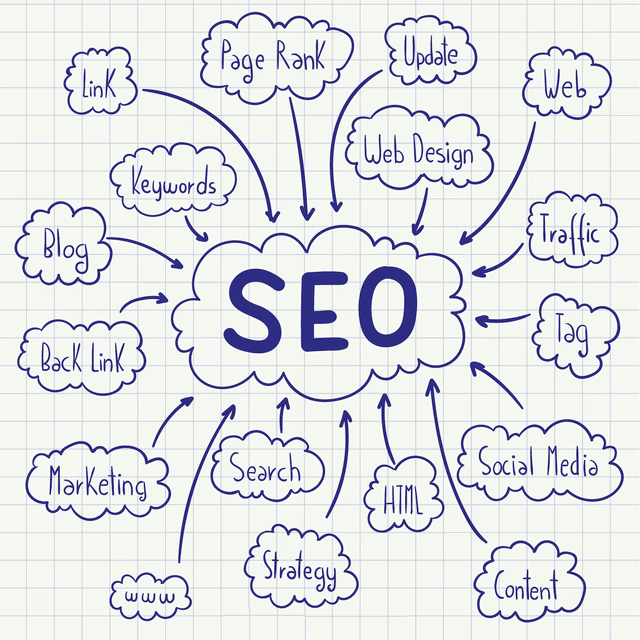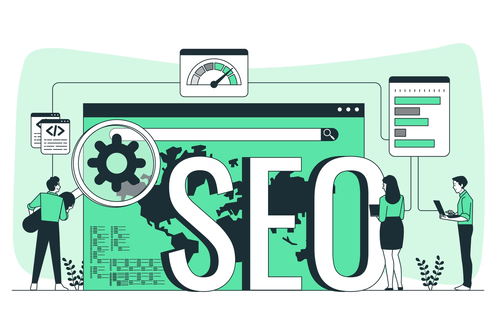SEO is a difficult thing for businesses to manage. There are lots of agencies out there that promise the world and fail to deliver. Even getting a clear view of the work being done can be a nightmare with every question getting vague answers. With Revelate we give you straightforward reporting so you always have transparency. With that in mind we’ve detailed our process for SEO so you have clarity on what to expect and what we deliver.

SEO, in a nutshell, are the strategies and tactics people use to optimise their pages for search engines so they show up higher in the search results. The two main ways to benefit are to appear for as many relevant keywords and phrases as possible and then to appear as high as possible in the search rankings. If you can appear on the first page of Google you’ll get far more visitors to your site and that means more customers and more sales.
Worldwide companies spend over $50 billion a year on SEO. From the largest companies like Amazon and Coca Cola to your local furniture or book store companies have long recognised the benefits of SEO as it provides a lasting benefit and has no limits on how many you can reach unlike Google Ads or Social Media which will cap your exposure based on follower size or ad spend.
But not everyone can appear at the top of Google so it’s important to have a proper SEO strategy, the correct one for you and a strong agency that can do the work for you. In this article we will be focusing on content structures.
First Steps of SEO
Understanding Your Business
When starting an SEO campaign, the first step is to get to know the business. This process is called business discovery, and it involves meeting with you and gathering information about your business, your goals, and your target audience. This stage is crucial because it sets the foundation for the entire SEO campaign.
During the business discovery stage, we will ask you a series of questions to get a better understanding of your business. These questions will cover a wide range of topics, from the products or services you offer to your target audience and competitors. We will also look to find out what differentiates you from your competitors. By focusing on what makes you stand out we can be better placed to make the most of your advantages. We will also ask about your goals for the SEO campaign, such as increasing website traffic or generating more leads.
One important aspect of business discovery is understanding your target audience. This includes demographic information, such as age, gender, and location, as well as psychographic information, such as interests and behaviors. We will use this information to develop a comprehensive SEO strategy that targets the right audience with the right messaging.
Auditing Your Site

The audit process is a thorough analysis of your site’s current performance, including its technical structure, content, and off-site factors. By conducting a comprehensive site audit, we can identify any issues that could be holding back your site’s ranking potential and develop a strategy to improve your site’s performance.
The technical structure of your site is crucial for search engines to crawl, understand, and index your site. This includes factors such as website speed, mobile-friendliness, and URL structure. According to Google, more than 50% of web traffic comes from mobile devices, so a mobile-friendly site is crucial for SEO success. In addition, website speed is a critical ranking factor for Google, and a slow site can negatively impact your site’s visibility. A recent study found that a one-second delay in page load time can result in a 7% reduction in conversions.
Content is the backbone of any SEO campaign. Your site’s content should be informative, engaging, and relevant to your target audience. It should also be optimized with relevant keywords and structured in a way that’s easy for search engines to understand. A clearly understood schema is also a key part in modern SEO with it allowing search engines to more easily crawl your website. Our content audit process includes a review of your site’s existing content, keyword research, and competitor analysis. We develop a content strategy that’s tailored to your business and target audience, and optimize your content to improve its search engine visibility.
Keyword Research
Keywords are the words or phrases that people type into search engines to find information. By optimizing your website for the right keywords, you can increase your website’s visibility in search engine results pages (SERPs) and drive more traffic to your site.
High volume keywords are important because they have a high search volume, which means that a lot of people are searching for them. According to a study by Ahrefs, the top 10% of keywords account for 90% of all search traffic. That’s why it’s essential to target high volume keywords that are relevant to your business. However, it’s important to note that high volume keywords are often highly competitive, which means that it can be challenging to rank for them.
Long-tail keywords are longer, more specific phrases that are less competitive but often have a higher conversion rate. According to a study by Moz, long-tail keywords account for 70% of all search traffic. By targeting long-tail keywords, you can reach a more targeted audience that is more likely to convert into customers.
Expanding the number of keywords your site ranks for is helpful because it increases the chances of your website appearing in search engine results pages for a variety of search terms. This can help drive more traffic to your site and increase your chances of converting visitors into customers.
When selecting keywords, it’s important to consider relevance, authority, and search volume. Relevance refers to how closely the keyword relates to your business or industry. Authority refers to how authoritative your website is in the eyes of search engines. Search volume refers to how many people are searching for the keyword each month.
User intent is also a critical factor to consider in keyword research. User intent refers to the reason behind a user’s search query. Understanding user intent can help you select the right keywords and optimize your content to meet the needs of your target audience. For example, if someone searches for “best restaurants in Dublin City,” their intent is likely to find recommendations for restaurants in Dublin City. Understanding this intent can help you create content that meets their needs and provides value to your target audience.
Competitor Analysis
Competitor analysis involves researching and analysing the strategies of your competitors to identify opportunities and gain a competitive advantage. In today’s competitive digital landscape, understanding your competitors and their SEO strategies is essential for staying ahead of the game.
One of the main reasons why competitor analysis is important is that it allows you to identify your competitors’ strengths and weaknesses. By analysing their SEO strategies, you can gain insights into what’s working and what’s not. This information can then be used to develop a tailored SEO strategy that takes advantage of your competitors’ weaknesses and builds upon their strengths.
To conduct effective competitor analysis, it’s important to start by identifying your top competitors. These are the businesses that are ranking well for your target keywords and are therefore the most likely to be competing for your target audience. Once you’ve identified your top competitors, you can start to analyse their SEO strategies. This can involve analysing their website structure, content, backlink profile, and social media presence.
One of the biggest challenges of competitor analysis is that it can be time-consuming and labour-intensive. However, there are tools and resources available that can make the process more manageable. For example, tools like SEMRush and Ahrefs can help you analyze your competitors’ backlink profiles, while analytics can help you identify their top-performing pages and keywords.
Another important aspect of competitor analysis is looking for and identifying opportunities. By analysing your competitors’ strategies, you may identify gaps in their content or backlink profile that you can fill. For example, if your competitors aren’t targeting a specific keyword, you may be able to rank for it and gain a competitive advantage.
It’s important to note that competitor analysis is an ongoing process. Your competitors are constantly adapting their SEO strategies, so it’s important to stay up-to-date on their tactics and adjust your own strategy accordingly.
Implementing Your SEO Strategy
Building Your SEO Strategy
In business discovery, we got to know your company, your goals, and your target audience. The website audit allowed us to identify any technical issues that may be impacting your website’s performance in search results. We then used keyword research to identify the most relevant and valuable keywords for your business, including high volume and long-tail keywords. Competitor analysis helped us understand the competitive landscape in your industry and identify areas where we can gain an advantage.
Based on these building blocks, we develop a personalized SEO strategy that includes specific actions with a timeline for implementation. Our goal is to provide transparency throughout the process and ensure that you have a clear understanding of what we are doing and why.
Different businesses may require different strategies. For example, a local business may focus on optimizing for location-based keywords to increase visibility in local search results. On the other hand, an e-commerce business may focus on optimizing product pages for specific keywords to improve sales. We work with each client to develop a strategy that is tailored to their unique needs and goals.
It is important to note that SEO is a process that takes time and effort. However, the benefits can be long-lasting and have a significant impact on your business’s success online. By hiring an experienced agency with a proven track record of positive results, you can trust that your SEO strategy is in good hands. We are committed to providing the best possible service and helping you achieve your online business goals.
Technical SEO
Technical SEO involves optimizing your website’s technical elements to ensure search engine crawlers can effectively crawl, index and understand your site. It helps to ensure that your site is free of any technical issues that may hinder your site’s performance on search engines.
One of the most important elements of technical SEO is site speed. Google has stated that page speed is a ranking factor, and that faster sites are more likely to rank higher in search engine results pages (SERPs). A study by Backlinko found that pages with fast loading speeds have a higher chance of ranking on the first page of Google search results. Our team of experts can optimize your website’s speed and reduce load times to enhance the user experience and boost your search engine rankings.
Another critical component of technical SEO is mobile-friendliness. With mobile devices accounting for a significant proportion of web traffic, it is important to ensure your website is optimized for mobile users. Google uses mobile-first indexing, which means that it primarily uses the mobile version of your site’s content to rank pages. By ensuring that your site is mobile-friendly, you can improve your visibility in mobile search results and attract more mobile users.
A third important element of technical SEO is ensuring that your website is secure with an SSL certificate. Google has confirmed that HTTPS is a ranking factor, and sites with SSL certificates are likely to rank higher in search engine results pages. Not only does having an SSL certificate improve your website’s ranking, but it also protects your users’ data, increasing trust in your site.
Improving your website’s technical SEO can have significant benefits for your business. According to a study by Google, websites that load within 5 seconds have 70% longer average sessions, 35% lower bounce rates, and generate up to 25% more ad views. Additionally, a study by SEMrush found that fixing technical SEO issues can result in a 14% increase in organic traffic on average.
Page Optimisation

On-page optimisation refers to the process of optimising individual web pages in order to rank higher and earn more relevant traffic in search engines. It involves ensuring that your website is structured and coded in a way that is easily readable by search engines, and that the content on your site is high-quality, relevant and optimised for the keywords that you are targeting.
When it comes to on-page optimization, there are several key elements that we focus on to ensure your website is fully optimized for search engines.
Firstly, page titles are a crucial element of on-page optimization. Each page should have a unique and descriptive title that accurately reflects the content on the page. It is important to include your target keywords in the title, but be careful not to overdo it as this could be seen as spammy by search engines.
Headers are another important element of on-page optimization. Each page should have a clear and logical hierarchy of headers, with the main heading (H1) being used to describe the main topic of the page. Subheadings (H2, H3, etc.) can be used to break up the content and provide additional context for search engines.
Meta descriptions are short snippets of text that appear below the page title in search engine results. While they don’t directly impact rankings, they can influence click-through rates by providing a brief summary of the content on the page. We ensure that each page on your website has a unique and compelling meta description that accurately reflects the content of the page.
Structured markup, also known as schema markup, is a type of code that provides additional information about the content on your website to search engines. This can include things like business information, product details, and reviews. By using structured markup, we can help search engines better understand the content on your website, which can lead to improved rankings and visibility.
URL structure is another important element of on-page optimization. URLs should be descriptive and easy to read, with target keywords included where appropriate. We also ensure that URLs are kept as short as possible to avoid confusing search engines and users.
Finally, internal linking is an important on-page optimization technique that involves linking from one page on your website to another. This can help to improve the user experience by providing additional context and information, and can also help search engines to better understand the structure and hierarchy of your website. We ensure that each page on your website is linked to from other relevant pages, using descriptive anchor text where appropriate.
Improving your on-page optimisation can have a significant impact on your website’s search engine rankings and overall visibility. According to recent studies, websites with strong on-page optimisation are more likely to rank higher in search engine results pages (SERPs) and attract more organic traffic. In fact, one study found that on-page SEO was the most important factor in determining a website’s search engine rankings, accounting for 23.2% of the total ranking factors.
Creating Content
Creating high-quality, relevant and engaging content is crucial to improving your website’s visibility in search results, increasing your website traffic and generating leads.
There are several types of content that we recommend to our clients, including blogs, articles, reviews, case studies and videos. These types of content allow you to showcase your expertise and knowledge in your industry, while also providing valuable information and insights to your target audience.
In addition to creating regular content, we also recommend creating cornerstone content and evergreen content. Cornerstone content is the foundation of your website’s content and includes in-depth, comprehensive information on your main topics or services. Evergreen content is content that remains relevant and valuable over time, and continues to drive traffic to your website long after it is published.
The benefits of creating cornerstone content and evergreen content are numerous. Cornerstone content helps establish your website as an authority in your industry, while evergreen content continues to attract traffic and generate leads over time, without the need for ongoing updates.
When creating content, it’s important to focus on quality over quantity. Google’s algorithms favour high-quality content that provides value to users, and penalise low-quality or spammy content. This means that investing in the creation of high-quality content is essential to achieving SEO success.
At our agency, we work closely with our clients to develop a content strategy that aligns with their business goals and objectives. This includes conducting research on your target audience and industry, identifying relevant topics and keywords, and creating a content calendar to ensure consistent, high-quality content is published on a regular basis.
In addition to creating content, we also recommend promoting your content through social media, email marketing and other channels to increase its visibility and reach. By creating and promoting high-quality content, you can improve your website’s SEO, increase traffic and generate leads for your business.
Continuous Improvement
Transparent Reporting

At our agency, we believe in transparent reporting and keeping our clients informed every step of the way. That’s why we provide a monthly report that shows the progress made in the key SEO areas we’re working on.
The monthly report will typically include a summary of the actions taken over the month, as well as the results achieved. We’ll outline the work we’ve done on your site, such as the technical updates, keyword research, and content creation. We’ll also highlight any wins, such as ranking improvements, increased traffic or engagement, and any other positive developments.
We understand that SEO can sometimes feel like a bit of a black box, which is why we want to make sure you feel informed and empowered throughout the process. Our reporting will be transparent and easy to understand, and we’ll always be available to answer any questions you may have.
Transparency is not only essential for building trust with our clients, but it also helps us to identify any areas for improvement or opportunities for growth. By regularly reviewing and reporting on the progress we’re making, we can refine our approach and adjust our strategy if necessary.
Our monthly report also allows you to track the return on investment (ROI) of your SEO efforts. You’ll be able to see the results of the work we’re doing and the impact it’s having on your business. By measuring the results of our efforts, we can continuously improve and refine our approach to deliver even better results.
Building on Initial SEO Work
In the world of SEO, consistency is key. While it’s crucial to start with a strong foundation and to optimize your website, ongoing work is necessary to maintain and improve your search rankings. Without regular attention and adjustments, your website can quickly lose momentum, making it harder to achieve and maintain the results you desire. Therefore, it’s important to implement an ongoing SEO strategy that includes a range of tasks that work together to keep your website on top.
- Content Creation and Optimization Creating and optimizing high-quality, relevant, and engaging content is crucial for SEO success. Content not only attracts potential customers, but it also signals to search engines that your website is an authoritative source on a particular topic. By consistently creating fresh content and optimizing it with targeted keywords, you can improve your search rankings, increase traffic, and establish your website as an industry leader.
- Link Building Link building involves acquiring high-quality backlinks from other authoritative websites in your industry. Backlinks serve as “votes of confidence” for your website, indicating to search engines that your website is a trusted and valuable resource. By building a diverse backlink profile, you can improve your website’s authority, trustworthiness, and search visibility.
- Technical SEO Technical SEO refers to the backend optimization of your website, including its structure, coding, and functionality. This includes elements such as website speed, mobile responsiveness, crawlability, and indexability. Technical SEO is important because it ensures that your website is accessible to search engines and that they can easily crawl and index your content.
- On-page Optimization On-page optimization involves optimizing individual pages on your website to improve their relevance and visibility for specific search queries. This includes optimizing title tags, meta descriptions, headers, and content. By optimizing on-page elements, you can make it easier for search engines to understand what your page is about and improve its chances of ranking for relevant search queries.
- Local SEO Local SEO is the process of optimizing your website and online presence to improve your visibility in local search results. This includes optimizing your Google My Business listing, building local citations, and acquiring reviews from satisfied customers. By optimizing for local search, you can attract more local customers and increase foot traffic to your physical location.
- Social Media Marketing Social media can be an effective channel for promoting your website and content, building brand awareness, and acquiring backlinks. By regularly sharing and promoting your content on social media platforms, you can attract more followers and increase the likelihood of your content being shared and linked to.
- Monitoring and Analytics Regularly monitoring your website’s analytics and performance metrics is essential for identifying areas of improvement and tracking the success of your SEO efforts. This includes monitoring your website’s traffic, bounce rate, click-through rate, and conversion rate. By tracking these metrics, you can identify areas of improvement and adjust your strategy accordingly.
- Keeping up with Industry Trends and Algorithm Changes SEO is an ever-evolving industry, and search engine algorithms are constantly changing. It’s important to stay up-to-date with the latest trends and algorithm changes to ensure that your SEO strategy remains effective. By staying informed and adapting your strategy as needed, you can stay ahead of the competition and continue to achieve SEO success.
All of these tasks work together to form a cohesive SEO strategy that helps your website maintain its search visibility and achieve long-term success. By consistently implementing these tasks and adjusting your strategy as needed, you can maintain and improve your search rankings, increase traffic, and achieve your business goals.

